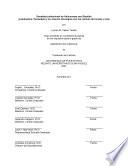Autores del Libro:
Resumen del Libro:

Helicoverpa zea (Boddie) is the most important insect pest of tomato, Lycopersicum esculentum (Mill.), and corn, Zea mays L. A study was conducted (2003-2004) to estimate the density and phenology of H. zea in commercial fields of tomato (Gargiulo, Santa Isabel) and corn (Mycogen, Santa Isabel, Pioneer, Salinas). The number of adults was estimated based on moths collected in pheromone-baited Heliothis traps. At each locality, 25 plants were sampled for H. zea eggs and larvae. Data were grouped into four seasons and four phenological stages. H. zea eggs and larvae where moderately aggregated in tomato trifoliates and fruits and in corn ears. Higher numbers of H. zea eggs and larvae were found in Mycogen and Pioneer than in Gargiulo in winter and spring. Peak adult numbers were observed in spring for Mycogen and Pioneer, and both were higher than Gargiulo. In terms of crop phenology, higher number of eggs and larvae were found at Mycogen and Pioneer in the reproductive and maturation stages of corn and these were higher than in Gargiulo, where the senescence stage was the highest. Tomato was planted in pure stands and intercropped with corn (planted at 0, 7, and 14 days after tomato) at Juana Diaz Agricultural Experiment Station (2004, 2005). Higher numbers of H. zea eggs and larvae were found on corn in the reproductive stage of intercrop treatments. In pure tomato stands higher numbers of H. zea eggs and larvae were found as tomato reached the maturation stage. The application of these study findings for managing H. zea in a tomato and corn agroecosystem is discussed.
Formatos Disponibles: PDF / EPUB
Opciones de descarga:
Si deseas obtener una copia del libro puedes usar alguna de las siguientes opciones de descarga:
